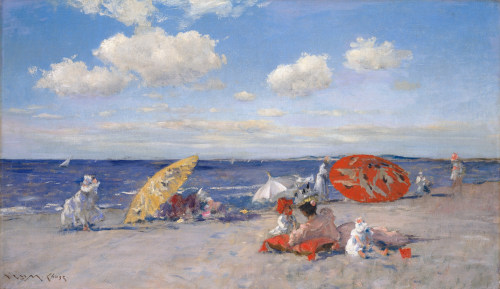William Merritt Chase

At the Seaside, ca. 1892
William Merritt Chase (1849 – 1916)
In the early 1880s William Merritt Chase began to paint the plein-air landscapes that would earn him recognition as one of America’s leading Impressionists. Brushed quickly with a bright palette, Chase’s landscapes bear the touch of spontaneity. Describing them as “veritable little jewels,” fellow painter Kenyon Cox said, “They are far and away the best things Mr. Chase has yet done. . . . They are perfection in their way and could not be improved upon.” Chase delighted in capturing the carefree visual appeal of familiar sites and leisure activities. He once declared, “If you want to know of good places to sketch in the vicinity of New York . . . I think I could easier tell you where they are not than where they are.” Chase also worked frequently with pastel—a medium then rapidly gaining vogue.
Chase was born in Williamsburg, Indiana, to Sarah Swaim and David Hester Chase. In 1861 the family moved to Indianapolis, where Chase received private drawing lessons from a local teacher. Chase studied briefly at the National Academy of Design in New York before enrolling, in 1872, in the Royal Academy in Munich, where he met Frank Duveneck and developed an appreciation for the painterly quality of seventeenth-century art. During this decade he painted still lifes, portraits, and figurative interiors with a palette dominated by rich browns, yellows and pearly grays inspired by the Old Master paintings he so admired. Chase returned to New York in 1878 in order to accept a teaching position at the Art Students League and quickly aligned himself with the most progressive arts organizations in the city.
Biography
On a return visit to Europe in 1881, Chase traveled first to Paris, where he met Mary Cassatt and John Singer Sargent. Both artists had visited Spain and had ample information to share with their less-traveled colleague. Chase departed for Spain alone on July 2, 1881, with the goal of viewing and copying paintings by Diego Velazquez. The following summer, traveling with a group of artists that included Robert Frederick Blum and Frederick Porter Vinton, he made a second trip to the Spanish peninsula. On that trip Chase painted sun-drenched views en plein air and studied the sparkling paintings and watercolors of Mariano Fortuny.
In 1884 Chase visited Holland with Blum and Charles Ulrich. The artists originally intended only a brief stay in the Netherlands before continuing on to Venice, but when cholera broke out in Germany, Blum and Chase settled in the Dutch village of Zandvoort. Chase continued to work en plein air, and his own brand of Impressionism—based upon cool, vibrant blues and greens—began to emerge.
Although many of his American contemporaries—including Cassatt, Sargent, Ulrich, Edwin Austin Abbey, Gari Melchers, and Daniel Ridgway Knight—chose to remain in Europe, pursuing lucrative careers painting European subjects for an international clientele, Chase decided to establish himself in New York City. He secured the largest and finest studio available in the venerable Tenth Street Studio Building and devoted himself to promoting American art and supporting American artists. Chase was a flamboyant, charismatic personality, and his studio attracted a fashionable crowd of artists and other society figures.
Chase taught at the Art Students League of New York (1878-1896), the Brooklyn Art Association (1887, and again 1891-96), and the Pennsylvania Academy of the Fine Arts in Philadelphia (1896-1909). He also founded the Shinnecock Summer School of Art (1891) at his summer home near Southampton, Long Island, and the Chase School of Art in New York City (1896). Chase’s influence on subsequent generations of American artists was significant—both on the East Coast and, later, in California, where he taught in 1914. Notable pupils included the brothers Gifford and Reynolds Beal, Patrick Henry Bruce, Arthur B. Carles, Daniel Garber, Charles Webster Hawthorne, John Marin, Georgia O’Keeffe, Charles Sheeler, and Martha Walter.
Today, Chase’s work is represented in public collections throughout the United States and around the world. Important collections include the Metropolitan Museum of Art, New York; Akron Art Museum, Ohio; Butler Institute of American Art, Youngstown, Ohio; Detroit Institute of Arts, Detroit, Michigan; Carnegie Institute, Pittsburgh; Hirshhorn Museum and Sculpture Garden, Smithsonian Institution, Washington, D. C.; Parrish Art Museum, Southampton, New York; Toledo Museum of Art, Ohio; Milwaukee Art Museum, Wisconsin; Neue Pinakothek, Munich; Pennsylvania Academy of the Fine Arts, Philadelphia; and Joslyn Art Museum, Omaha, Nebraska.
Biography from the Archives of AskART.